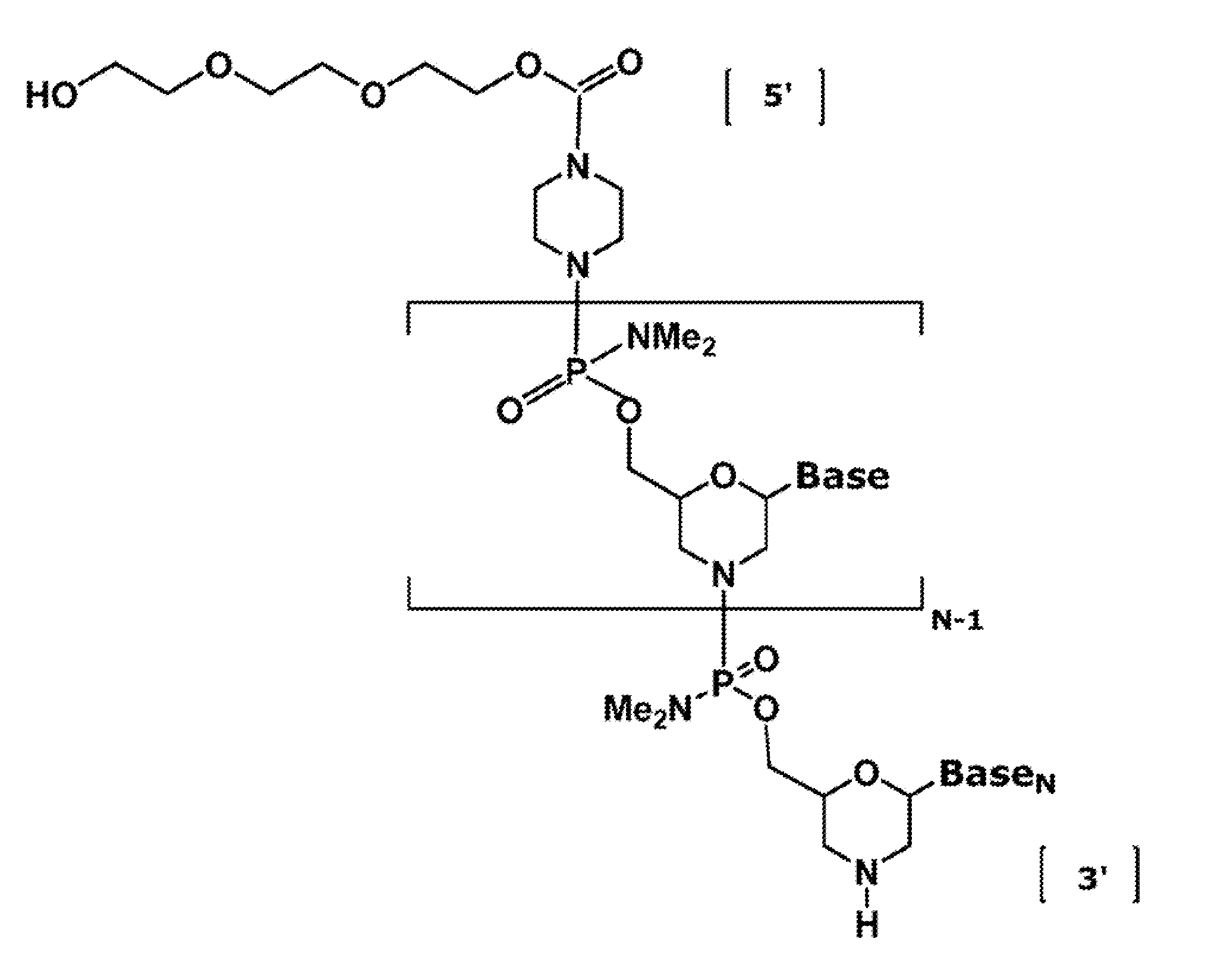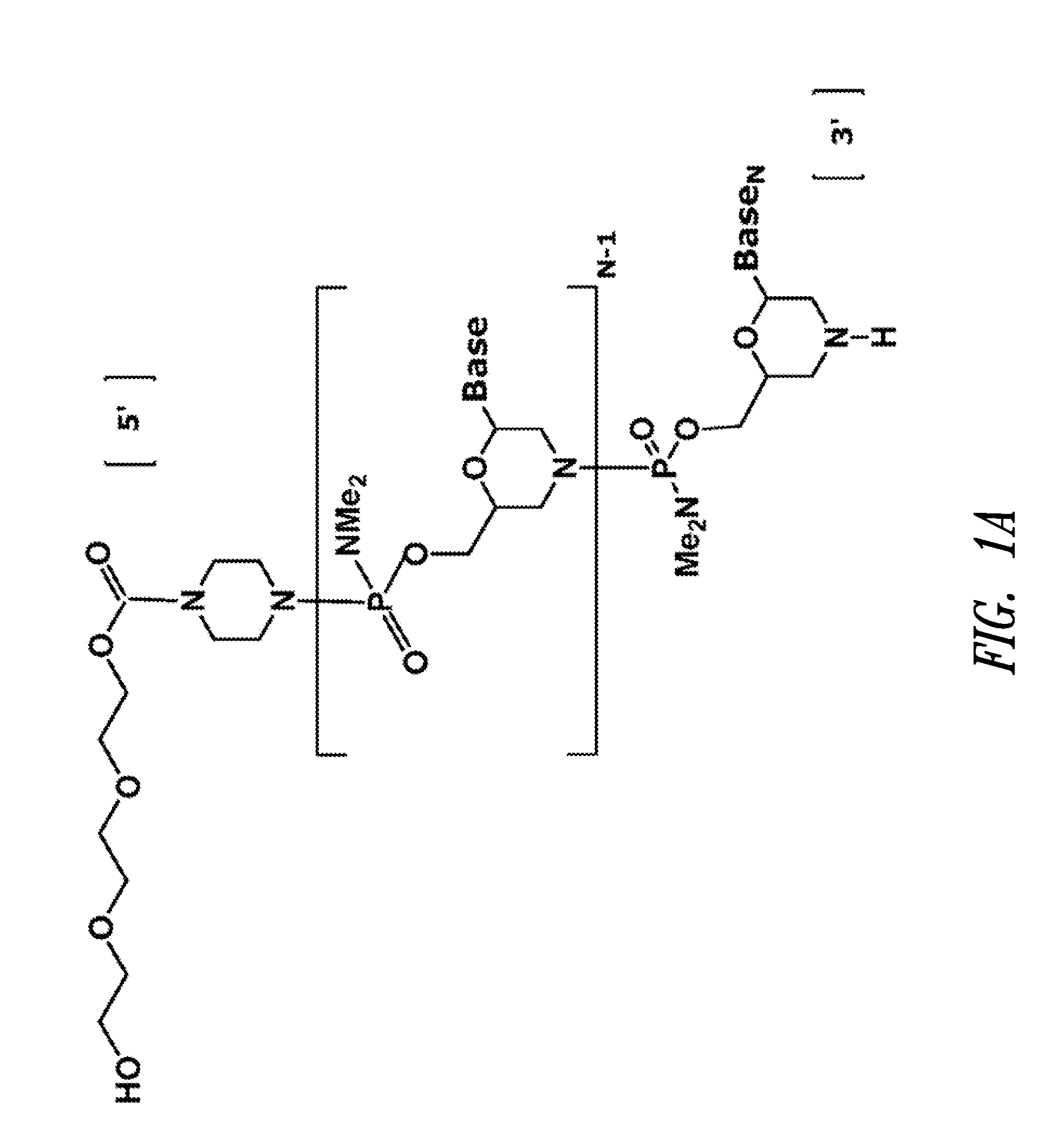Antisense antiviral compound and method for treating influenza viral infection
an antiviral compound and influenza virus technology, applied in the field of antiviral oligonucleotides, can solve the problems of significant mortality and morbidity, influenza viruses have been a major cause of human mortality and morbidity, and vaccination does not provide protection against unexpected strains
- Summary
- Abstract
- Description
- Claims
- Application Information
AI Technical Summary
Benefits of technology
Problems solved by technology
Method used
Image
Examples
example 1
Inhibition of Influenza a Virus in a Murine Model System
[0330]A murine model of influenza A virus infection was used to determine the in vivo efficacy of representative antisense oligomers of the infection. Influenza A subtype H2N3 (Port Chalmers / 1 / 73) was used to infect Balb / c female mice via intranasal administration of approximately 4×104 plaque-forming units in a 50 microliter volume. The studies used 12 mice per group with six removed on day two for determination of viral titer and six removed on day six for determination of viral titer. Secondary endpoints included prevention of weight loss and survival.
[0331]Three test antisense oligomer compounds, PB1-AUG+15, M1 / M2-AUG and NP-v3′ (SEQ ID NOs:12, 13 and 30-33) as listed in Table 1 and below in Table 6 were evaluated as both peptide conjugated (PPMO) and positive charge linkage chemistry (PMOplus™). The PPMOs were synthesized using the CP06062 peptide (SEQ ID NO:124) conjugated to the 3′ terminus of the PMO. Each test agent wa...
example 2
Inhibition of Influenza a Virus in a Ferret Model System
[0333]One observation in support of the present invention was the demonstration of antiviral efficacy of the compounds of the invention in the domestic ferret (Mustela putorius furo) animal model system using the novel H1N12009 (S-OIV) virus. Advantages of the ferret model include the ability to use natural human isolate of influenza virus, as opposed to mouse-adapted strains, and the development of most clinical signs observed in humans such as fever and nasal discharge (Munster, de Wit et al. 2009).
[0334]Six ferrets were infected with a Tamiflu-resistant H1N1 strain from 2009 obtained from the Centers for Disease Control (pandemic swine flu). The route of viral infection was intranasal (4×104 plaque-forming units) on Day 1 and dosing was either by intraperitoneal (ip) injection for the PMOplus™ compounds or intranasal (in) for the PPMO compounds. The Dengue-targeted negative control PMOplus™ (30 mg / kg ip dose) and PPMO (1.5 m...
example 3
Inhibition of Influenza a Virus in Tissue Culture Using Splice Site-Targeted Antisense Oligomers
[0341]An aspect of the present invention is the inhibition of influenza A virus replication by antisense targeting of multiple sites within the M1 / M2 segment. In addition to inhibition of translation by targeting the common M1 / M2 AUG start site, splice donor and splice acceptor sites can also be targeted using compounds of the invention. Two PMO that target the splice acceptor site at position 740 were synthesized as peptide conjugated PPMO, SA740 and SA746 (SEQ ID NOs: 26 and 29, respectively) and placed into an in vitro tissue culture replication system for H1N1 strain PR8. The P007 cell penetrating peptide (SEQ ID NO: 118) was conjugated to the 3′ terminus of the PMO.
[0342]An alveolar murine macrophage cell line (ATCC; AMJ2-C11) was infected at 0.1 MOI with H1N1 (strain PR8) and 1 hour post-infection PPMOs were added. Cells were incubated at 35 degrees C. overnight. Viral supernatant w...
PUM
| Property | Measurement | Unit |
|---|---|---|
| Tm | aaaaa | aaaaa |
| Tm | aaaaa | aaaaa |
| Tm | aaaaa | aaaaa |
Abstract
Description
Claims
Application Information
 Login to View More
Login to View More - R&D
- Intellectual Property
- Life Sciences
- Materials
- Tech Scout
- Unparalleled Data Quality
- Higher Quality Content
- 60% Fewer Hallucinations
Browse by: Latest US Patents, China's latest patents, Technical Efficacy Thesaurus, Application Domain, Technology Topic, Popular Technical Reports.
© 2025 PatSnap. All rights reserved.Legal|Privacy policy|Modern Slavery Act Transparency Statement|Sitemap|About US| Contact US: help@patsnap.com



